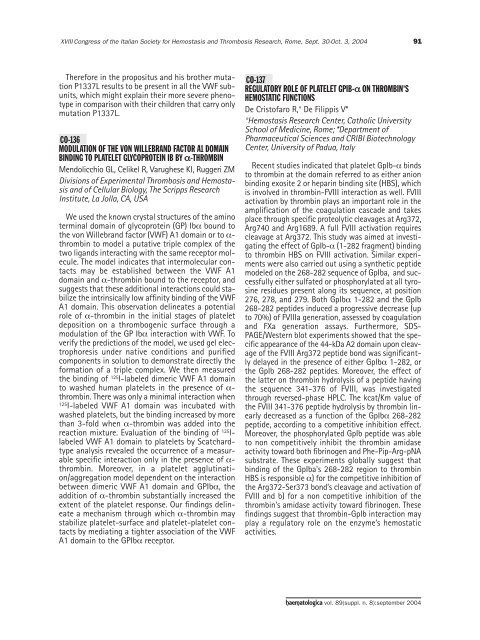Haematologica 2004;89: supplement no. 8 - Supplements ...
Haematologica 2004;89: supplement no. 8 - Supplements ...
Haematologica 2004;89: supplement no. 8 - Supplements ...
- No tags were found...
You also want an ePaper? Increase the reach of your titles
YUMPU automatically turns print PDFs into web optimized ePapers that Google loves.
XVIII Congress of the Italian Society for Hemostasis and Thrombosis Research, Rome, Sept. 30-Oct. 3, <strong>2004</strong>91Therefore in the propositus and his brother mutationP1337L results to be present in all the VWF subunits,which might explain their more severe phe<strong>no</strong>typein comparison with their children that carry onlymutation P1337L.CO-136MODULATION OF THE VON WILLEBRAND FACTOR A1 DOMAINBINDING TO PLATELET GLYCOPROTEIN IB BY α-THROMBINMendolicchio GL, Celikel R, Varughese KI, Ruggeri ZMDivisions of Experimental Thrombosis and Hemostasisand of Cellular Biology, The Scripps ResearchInstitute, La Jolla, CA, USAWe used the k<strong>no</strong>wn crystal structures of the ami<strong>no</strong>terminal domain of glycoprotein (GP) Ibα bound tothe von Willebrand factor (VWF) A1 domain or to α-thrombin to model a putative triple complex of thetwo ligands interacting with the same receptor molecule.The model indicates that intermolecular contactsmay be established between the VWF A1domain and α-thrombin bound to the receptor, andsuggests that these additional interactions could stabilizethe intrinsically low affinity binding of the VWFA1 domain. This observation delineates a potentialrole of α-thrombin in the initial stages of plateletdeposition on a thrombogenic surface through amodulation of the GP Ibα interaction with VWF. Toverify the predictions of the model, we used gel electrophoresisunder native conditions and purifiedcomponents in solution to demonstrate directly theformation of a triple complex. We then measuredthe binding of 125 I-labeled dimeric VWF A1 domainto washed human platelets in the presence of α-thrombin. There was only a minimal interaction when125I-labeled VWF A1 domain was incubated withwashed platelets, but the binding increased by morethan 3-fold when α-thrombin was added into thereaction mixture. Evaluation of the binding of 125 I-labeled VWF A1 domain to platelets by Scatchardtypeanalysis revealed the occurrence of a measurablespecific interaction only in the presence of α-thrombin. Moreover, in a platelet agglutination/aggregationmodel dependent on the interactionbetween dimeric VWF A1 domain and GPIbα, theaddition of α-thrombin substantially increased theextent of the platelet response. Our findings delineatea mechanism through which α-thrombin maystabilize platelet-surface and platelet-platelet contactsby mediating a tighter association of the VWFA1 domain to the GPIbα receptor.CO-137REGULATORY ROLE OF PLATELET GPIB-α ON THROMBIN'SHEMOSTATIC FUNCTIONSDe Cristofaro R,° De Filippis V*°Hemostasis Research Center, Catholic UniversitySchool of Medicine, Rome; *Department ofPharmaceutical Sciences and CRIBI Biotech<strong>no</strong>logyCenter, University of Padua, ItalyRecent studies indicated that platelet GpIb-α bindsto thrombin at the domain referred to as either anionbinding exosite 2 or heparin binding site (HBS), whichis involved in thrombin-FVIII interaction as well. FVIIIactivation by thrombin plays an important role in theamplification of the coagulation cascade and takesplace through specific proteolytic cleavages at Arg372,Arg740 and Arg16<strong>89</strong>. A full FVIII activation requirescleavage at Arg372. This study was aimed at investigatingthe effect of GpIb-α (1-282 fragment) bindingto thrombin HBS on FVIII activation. Similar experimentswere also carried out using a synthetic peptidemodeled on the 268-282 sequence of GpIba, and successfullyeither sulfated or phosphorylated at all tyrosineresidues present along its sequence, at position276, 278, and 279. Both GpIbα 1-282 and the GpIb268-282 peptides induced a progressive decrease (upto 70%) of FVIIIa generation, assessed by coagulationand FXa generation assays. Furthermore, SDS-PAGE/Western blot experiments showed that the specificappearance of the 44-kDa A2 domain upon cleavageof the FVIII Arg372 peptide bond was significantlydelayed in the presence of either GpIbα 1-282, orthe GpIb 268-282 peptides. Moreover, the effect ofthe latter on thrombin hydrolysis of a peptide havingthe sequence 341-376 of FVIII, was investigatedthrough reversed-phase HPLC. The kcat/Km value ofthe FVIII 341-376 peptide hydrolysis by thrombin linearlydecreased as a function of the GpIbα 268-282peptide, according to a competitive inhibition effect.Moreover, the phosphorylated GpIb peptide was ableto <strong>no</strong>n competitively inhibit the thrombin amidaseactivity toward both fibri<strong>no</strong>gen and Phe-Pip-Arg-pNAsubstrate. These experiments globally suggest thatbinding of the GpIba's 268-282 region to thrombinHBS is responsible α) for the competitive inhibition ofthe Arg372-Ser373 bond’s cleavage and activation ofFVIII and b) for a <strong>no</strong>n competitive inhibition of thethrombin's amidase activity toward fibri<strong>no</strong>gen. Thesefindings suggest that thrombin-GpIb interaction mayplay a regulatory role on the enzyme’s hemostaticactivities.haematologica vol. <strong>89</strong>(suppl. n. 8):september <strong>2004</strong>
















